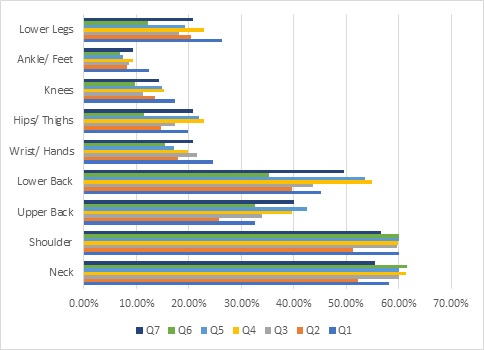Assessment of Health Issues and Online Working Ergonomics: A Case Study of the COVID-19 in Pakistan
Abstract
 Abstract Views: 36
Abstract Views: 36
The current study aims to evaluate and compare human factors and ergonomics during the lockdown of COVID-19 in Pakistan. The current research was done by conducting online surveys, using Nordic Musculoskeletal Questionnaire, Jenkin’s Sleep scale, and the COVID-19 Phobia scale. Data analysis was performed statistically by employing Microsoft Excel and Statistical Package for the Social Sciences (SPSS). The sample size considered for the current study was of 421 respondents. The results revealed that various ergonomics and other health issues occurred causing depression, anxiety, insomnia, hypertension, and PTSD. The most affected body parts were the neck (58.42%), shoulders (58.25%), lower back (45.95%), upper back (35.27%), lower legs (19.98%), wrist/hands (19.61%), hips/thighs (18.42%), knees (13.48%), and ankles/feet (8.8%). It has been concluded that an ergonomically designed workstation, adequate illumination, and specific adjustment of the screen of the display screen gadgets with eye level may assist in the prevention of the observed problems. Thereby, this study suggests that exercising and ergonomics can help to control health problems, caused as an effect of the COVID-19 pandemic.
Downloads

Copyright (c) 2023 Zaima Naveed, Neha Ali, Abdullah, Kamran Muzammal, Azhar Ali, Zaghum Abbas

This work is licensed under a Creative Commons Attribution 4.0 International License.
BSR follows an open-access publishing policy and full text of all published articles is available free, immediately upon publication of an issue. The journal’s contents are published and distributed under the terms of the Creative Commons Attribution 4.0 International (CC-BY 4.0) license. Thus, the work submitted to the journal implies that it is original, unpublished work of the authors (neither published previously nor accepted/under consideration for publication elsewhere). On acceptance of a manuscript for publication, a corresponding author on the behalf of all co-authors of the manuscript will sign and submit a completed the Copyright and Author Consent Form.









